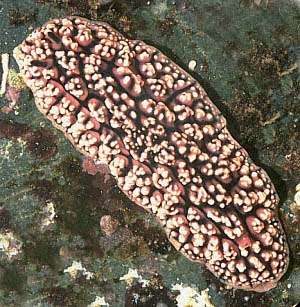
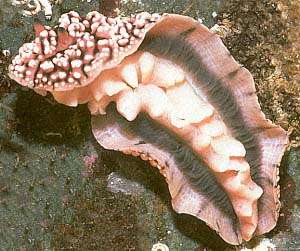
Phyllidiopsis fissuratus
Brunckhorst, 1993
Order: NUDIBRANCHIA
Suborder: DORIDINA
Family: Phyllidiidae
DISTRIBUTION
Known from southwestern tropical Pacific (Fiji, central Great Barrier Reef to Lord Howe Island).
PHOTO
UPPER: 9m, Flinders Reef, N of Cape Moreton, sthn Queensland, March 1984. Dorsal view of 79mm animal, holotype (Brunckhorst, 1993: Plate 9C).
LOWER: Ventral view (Brunckhorst, 1993: Plate 9D).
PHOTOS: R.C. Willan.
Notes from Brunckhorst,1993:
Phyllidiopsis fissuratus grows to about 79mm. has black background to dorsum and many tall, pale pink tubercles. The rhinophores are pink with a black tip and a black line down the posterior edge. It also has a translucent raised rim around the raised rhinophore pockets and a smooth tall raised pink anal papilla.
Two other species with similarly coloured rhinophores:
Phyllidiopsis pipeki, which has bright pink colouration and consistently two straight black longitudinal lines only, rounded white tubercles (not multicompound).
Phyllidiopsis krempfi, Large species characterised by predominantly pink coloration, and broad based multicompound tubercles with paler apices. Apart from two primary longitudinal black lines, other black lines of variable size occur irregularly. Rhinophores pink on anterior face and around base, black on apex and posterior face.
Reference:
• Brunckhorst, D.J. (1993) The systematics and phylogeny of Phyllidiid Nudibranchs (Doridoidea). Records of the Australian Museum, Supplement 16: 1-107.
Rudman, W.B., 1998 (December 12) Phyllidiopsis fissuratus Brunckhorst, 1993. [In] Sea Slug Forum. Australian Museum, Sydney. Available from http://www.seaslugforum.net/find/phylfiss
Related messages
Phyllidiopsis fissuratus from Fiji
July 17, 2003
From: Mary Jane Adams
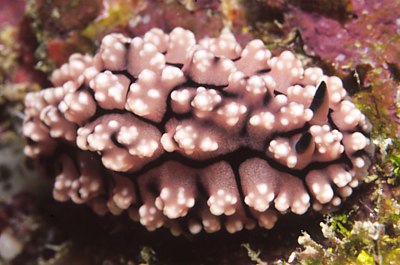
Hi Bill,
I can't tell if this is Phyllidiopsis fissuratus or P. krempfi.
What do you think?
Divesite: Vatu Vula, east of Vitu Levu, Fiji.
Length: 25 mm
Depth: 23 meters
Date:May 16, 2003.
Best regards,
Mary Jane
divepng@yahoo.com
Adams, M.J., 2003 (Jul 17) Phyllidiopsis fissuratus from Fiji. [Message in] Sea Slug Forum. Australian Museum, Sydney. Available from http://www.seaslugforum.net/find/10279Dear Mary Jane,
I am pretty sure this is Phyllidiopsis fissuratus. In P. krempfi the background colour of the mantle is pink with some black lines, while in P. fissuratus the whole of the background colour between the compound tubercles is black.
Best wishes,
Bill Rudman
Phyllidiopsis fissuratus f rom Malaysia
July 17, 2002
From: Richard Houghton
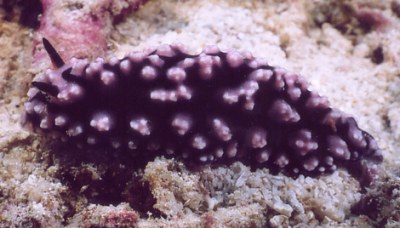
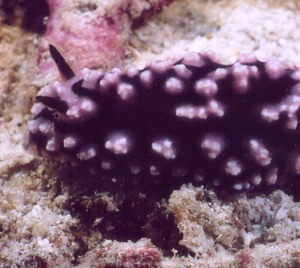
Bill,
Here is another phyllidiid found off Pulau Aur, Malaysia in May 2002.
Happy diving,
Rich
richard_houghton@hotmail.com
Houghton, R., 2002 (Jul 17) Phyllidiopsis fissuratus f rom Malaysia. [Message in] Sea Slug Forum. Australian Museum, Sydney. Available from http://www.seaslugforum.net/find/7545Dear Rich,
This is Phyllidiopsis fissuratus. It looks quite like Phyllidiopsis burni but one character that separates them - and I can see in your photo - is that the rhinophores in P. fissuratus are pink with a black tio and a black line down the posterior midline, as in your photo, while in P. burni the rhinophores are completely black.
best wishes,
Bill Rudman
Phyllidiopsis fissurata? from Hawaii
June 16, 2000
From: Scott Johnson
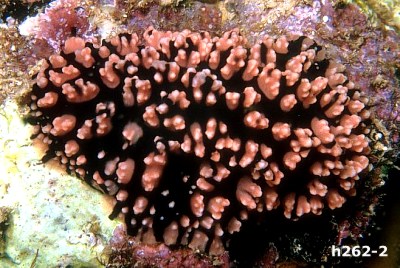
Hi Bill,
Attached is a photo of what I believe is Phyllidiopsis fissuratus. Although not visible in the photo, my notes on the specimen report pale pink rhinophores and dark gray gills, with the underside of the mantle light pink with some of the black axial streaks visible. This photo was taken in Hawaii, where I found several specimens along Oahu's north shore at depths of 10 to 20 meters. The specimens were 50 to 60mm in length. I have also found what appears to be the same species here in the Marshall Islands.
Scott
johnson@kmr.ll.mit.edu
Johnson, S., 2000 (Jun 16) Phyllidiopsis fissurata? from Hawaii. [Message in] Sea Slug Forum. Australian Museum, Sydney. Available from http://www.seaslugforum.net/find/2538Dear Scott,
It looks like P. fissurata to me. Your photo has captured the 'fissured' nature of the mantle very well.
Best wishes,
Bill Rudman.
Phyllidiopsis fissuratus from Vanuatu
February 17, 2000
From: Vinka Stenhouse
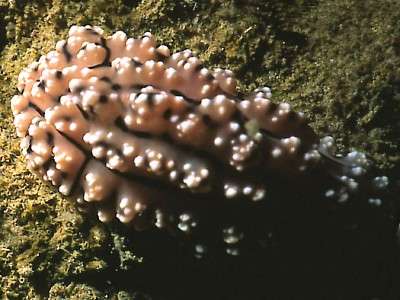
Dear Bill,
This one was found in 5 metres crawling over reef, Espiritu Santo Is., Vanuatu. 1998. It was 6cm long.
Yours sincerely,
Vinka Stenhouse.
Santo.
Vanuatu.
Dear Vinka,
This is Phyllidiopsis fissuratus. Previously only known from Fiji and tropical eastern Australia, Erwin Koehler has also found it in the Philippines. Your report from Vanuatu is an interesting, if not unexpected find.
Best wishes,
Bill Rudman.
Re: Philippines Phyllidiopsis?
January 28, 1999
From: Erwin Koehler
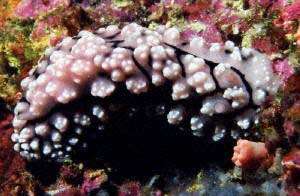
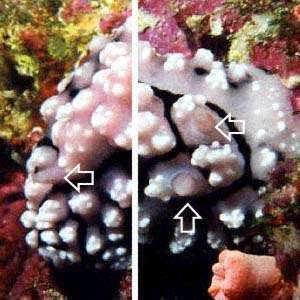
Dear Bill,
Concerning my earlier message which you identified as Phyllidiopsis krempfi. I think, I've been a little bit blind - there are two slugs at this photo, one rhinopore of the second one is clearly visible at the left
border of the photo: there are no typical black strips on the rhinopores of both specimen. The Rhinopores are light pink with a whitish top. I think they are not Ph. krempfi.
I've posted a larger version of this photo on the Philippines section of my
website
Erwin
Koehler, E., 1999 (Jan 28) Re: Philippines Phyllidiopsis?. [Message in] Sea Slug Forum. Australian Museum, Sydney. Available from http://www.seaslugforum.net/find/521Dear Erwin,
I've added an illustration showing the front and rear ends of your animal magnified. I don't think you were blind. I think the "rhinophore' at the rear end (left picture) is a long anal papilla! The only Phyllidiopsis with such a structure is Phyllidiopsis fissuratus. It is possible that is what your animal is. Against such a suggestion is:
(a) that it is only known from the southwest Pacific (but that is no great problem - you may just have increase its known distribution)
(b) its rhinophores don't seem to have the black line down the posterior edge (but maybe its aberrant, or we can't see the posterior edge clearly).
Another puzzling feature is that the rhinophores seem to have an associated tubercle (Brunckhorst's "rhinotubercle") which is supposed to be a feature of only Phyllidia and Fryeria. In short it's a bit of a puzzle. The main external feature of Phyllidiopsis is the fused oral tentacles which we can't see in the photo. It is also possible that this is a new species.
At the moment I have moved your message to Phyllidiopsis fissuratus but I can't say I'm 100% sure.
Best wishes,
Bill Rudman.
Phyllidia from Philippines
January 5, 1999
From: Erwin Koehler

Dear Bill,
this shot: Alona Bch, Panglao, Balicasag Is., Philippines, Oct. 1998, 25m (4cm long). I think it's a colour variant of Phyllidia elegans, but the rhinopores are WHITE and there are NO tubercles capped in yellow. Brunckhorst writes: "The background of the dorsum is black and the notal tubercles are pink and often capped in yellow. However some specimens may have only one or a few yellow-capped tubercles...The rhinopores are yellow..."
Erwin
Medslugs.Koehler@t-online.de
Koehler, E., 1999 (Jan 5) Phyllidia from Philippines. [Message in] Sea Slug Forum. Australian Museum, Sydney. Available from http://www.seaslugforum.net/find/440Dear Erwin,
I think it is a Phyllidiopsis and most probably P. krempfi. I know you can't see the typical black strips on the rhinophores but perhaps its the way the photograph appears -or perhaps the animal is damaged. I'm pretty sure its not Phyllidia elegans, which I'll try and post a page on, because the yellow rhinophores are very characteristic of that species. Also species of Phyllidia have a very characteristic tubercle associated with each rhinophore pocket. This structure, called a "rhinotubercle", is at the outside back of each rhinophore pocket and only occurs in Phyllidia and Fryeria.
Best wishes,
Bill Rudman.
